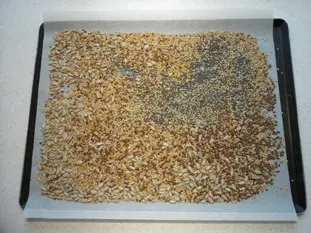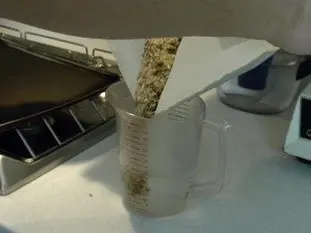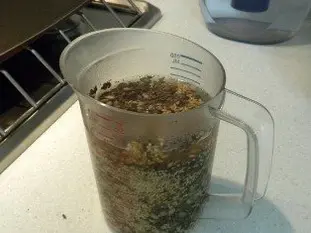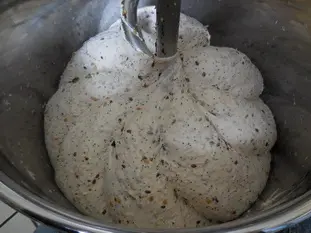This site uses only a few technical cookies necessary for its operation. By continuing to browse, you accept their use.
To find out more...
To find out more...
Making the most of seeds: Dry roasting

In cooking, and particularly in baking, there are a lot of seeds we can use, such as linseed, sesame, poppy, etc. Usually, recipes simply say to add them just as they are to the mixture or dough.
To make a seeded loaf, for example, prepare a plain bread dough as usual, then, towards the end of kneading, add around 200g (6 oz) of seeds per kilo (2 lb) of flour, generally a mixture of the seeds listed above. There is nothing wrong with this and your seeded bread will be good.
But there is one thing you should know, a bakers' secret, no less; there's a trick that will allow you to improve your recipe: you should dry roast the seeds before adding them.
To make a seeded loaf, for example, prepare a plain bread dough as usual, then, towards the end of kneading, add around 200g (6 oz) of seeds per kilo (2 lb) of flour, generally a mixture of the seeds listed above. There is nothing wrong with this and your seeded bread will be good.
But there is one thing you should know, a bakers' secret, no less; there's a trick that will allow you to improve your recipe: you should dry roast the seeds before adding them.
62 K 4.0/5 (25 reviews)
Last modified on: January 30th 2015
Making the most of seeds: Dry roasting
Dry roasting (or torrefaction) in this context is done by putting the seeds in a hot oven, which normally fills the kitchen with the delicious smell. This brief spell in the oven is too short to cook the seeds, but really brings out their flavour. This same principal lies behind roasting coffee, though this is a much longer process, or cocoa beans for making chocolate (the famous Maillard reactions).
To do this, you will need to preheat the oven to 360°F (180°C) and spread the seeds in an even layer on a baking sheet (line this with a sheet of cooking parchment to make handling the seeds afterwards easier).
Then put the seeds in the oven for about 15 minutes.
So, this is a simple way of achieving great results. Try it for yourself and you will be impressed at the difference it makes.
Just one detail to bear in mind for bread-making: if you add dry-roasted seeds to bread dough, be warned that they have an annoying tendency to absorb the water in the dough and leave it somewhat drier.
And as we are delving deep into bakers' secrets, here's the ultimate one: when using seeds in baking, dry-roast them, then as soon as they come out of the oven, tip them into their weight in water.
Leave them to soak up the water, which will take about 5 minutes, before adding them to the dough. Then you can enjoy all the flavour of the dry-roasted seeds without them taking the moisture from the bread and making it too dry.
This same dry-roasting method can also be used for nuts, such as almonds, pistachios, walnuts and hazelnuts. Try dry roasting them before you add them to a cake mixture, for example – the result might well surprise you.
To do this, you will need to preheat the oven to 360°F (180°C) and spread the seeds in an even layer on a baking sheet (line this with a sheet of cooking parchment to make handling the seeds afterwards easier).

Then put the seeds in the oven for about 15 minutes.

So, this is a simple way of achieving great results. Try it for yourself and you will be impressed at the difference it makes.
Just one detail to bear in mind for bread-making: if you add dry-roasted seeds to bread dough, be warned that they have an annoying tendency to absorb the water in the dough and leave it somewhat drier.
And as we are delving deep into bakers' secrets, here's the ultimate one: when using seeds in baking, dry-roast them, then as soon as they come out of the oven, tip them into their weight in water.


Leave them to soak up the water, which will take about 5 minutes, before adding them to the dough. Then you can enjoy all the flavour of the dry-roasted seeds without them taking the moisture from the bread and making it too dry.

This same dry-roasting method can also be used for nuts, such as almonds, pistachios, walnuts and hazelnuts. Try dry roasting them before you add them to a cake mixture, for example – the result might well surprise you.

To sum up
- It is better to dry roast seeds briefly in a hot oven before adding them to a dough
- When making bread, moisten the seeds with the same weight of water after roasting, before adding them to the dough
- You can also dry-roast almonds, pistachios, walnuts and hazelnuts
Lasts posts
Butter vs. grease
We often read in a recipe where a pastry is put into a mould that, just before pouring, the mould should be buttered or greased. But what's the difference between these 2 terms?December 1st 20259115
Getting out of the fridge early
Very often when you're cooking, you need to take food or preparations out of the fridge, to use them in the recipe in progress. There's nothing tricky about this: you just take them out of the fridge and use them, usually immediately, in the recipe. But is this really a good method?November 24th 20251,0635
Who's making the croissants?
When you look at a bakery from the outside, you naturally think that in the bakery, the bakers make the bread, and in the laboratory, the pastry chefs make the cakes. It's very often like that, with each of these professions having quite different ways of working, but sometimes there's also one...November 23th 2025958
Oven height
When we put a dish or cake in the oven, we naturally tend to put it on the middle shelf, and that's what we usually do. But in some cases, this position and height can be a little tricky, so let's find out why.October 8th 20252,6335
The importance of sieving
In recipes that use a fine powder (flour, powdered sugar, etc.), you'll often see the advice to sift before using it. To sift is to pass the powder in question through a sieve (a very fine strainer) before incorporating it into your recipe. It's often advice, but is it really useful?September 3rd 20257,4663
Other pages you may also like
The window-pane test in bread-making
The home bread-makers often ask themselves “Have I kneaded my dough long enough?” . A good question, as dough that is insufficiently kneaded will not rise properly or will fall flat when the top is slashed, which is very frustrating. To know when the dough is ready, one can rely on the length...June 16th 202196 K 23.9
The 3 kinds of meringue
Meringue – what could be simpler? Just beaten egg whites with sugar added. This makes a fairly stiff mixture which can then be cooked in a cool oven to create those lovely, light confections. But in the world of professional patisserie, meringue comes in three different kinds. Even if the...June 14th 201364 K4.5
Candied fruits: don't get ripped off
Do you like candied fruit? You might like to nibble a handful or add it to a recipe, like a classic fruit cake or delicious Italian specialities like panettone or sicilian epiphany pie.June 21th 201767 K 24.2
Drawing a pattern in pastry
Often in the kitchen, in pastry-making, or in baking, we need to trace a pattern on a pastry. It's just a question of aesthetics but it has its effect after baking on a galette, pithiviers, pâté en croute (terrine in a pie crust), etc.May 23th 201935 K4.1
The 3 secrets of Parisian flan
A flan Parisien, or boulanger, is a simple yet delicious cake. A cream, a mixture of milk, eggs and sugar, is poured into a raw pastry base and baked in the oven until the pastry and cream are cooked. This is the simplest version of the recipe, probably the original one, but nowadays the cream...July 21th 202316 K4.7
Post a comment or question
Follow this page
If you are interested in this page, you can "follow" it, by entering your email address here. You will then receive a notification immediately each time the page is modified or a new comment is added. Please note that you will need to confirm this following.
Note: We'll never share your e-mail address with anyone else.
Alternatively: you can subscribe to the mailing list of cooling-ez.com , you will receive a e-mail for each new recipe published on the site.









